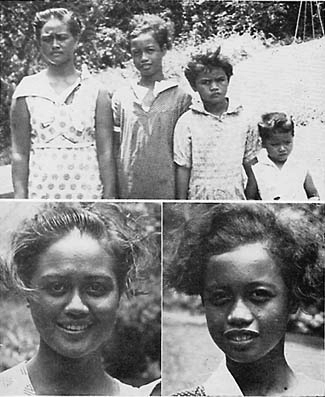
What if our nutrition during pregnancy, or heck even before conception, had lifelong consequences for the health of our children?
Let me rephrase that in case you have missed the enormity of the statement: what if what the parents ate and how they lived even before the child was even conceived may have an influence on, say, the probability of that child developing heart disease or cancer or diabetes at 60 years old?
In other words, what if genetics was not our entire destiny (for better or for worse) and good nutrition and a positive lifestyle went a long way in ensuring lifelong robustness?
Does this sound scary or empowering to you?
I believe it is empowering, and here’s why.
In part one of this article, I talked about Dr. Weston Price’s groundbreaking work as documented in Nutrition and Physical Degeneration (by the way you can check out the full book for free on that link). Starting out with the idea that many dental problems and malformations can be traced back to poor nutrition, he studied isolated traditional populations who had subsisted on their ancestral diets for generations and compared them to their counterparts who had been exposed to modern convenience foods for some time.
The people he studied and the geographies they inhabited were extremely diverse, something that was also reflected in their food. While the Eskimos and Native Americans subsisted on seal oil, salmon, fish eggs, caribou and berries, the Masai of East Africa on the meat, milk and blood of cattle, the people of the Swiss valley Loetschental on fresh dairy and rye, people of the Western islands of Scotland only fish, shellfish and oats in the absence of any other vegetation on their inhospitable islands… and the list goes on.
As I discussed in part one, he found that these people were for the most part an example of physical robustness, with perfect physical development including excellent oral health, and a resistance to the infectious and chronic diseases of the day like tuberculosis, cancer etc.
What he also found was that, while these people already ate extremely nutritious diets by today’s standards, they went even beyond this for the fertility period and had sacred foods that were procured especially for women (and even men) of childbearing age as well as growing children. These were foods that provided the body-building and body-repairing materials necessary for boosting fertility and supporting a growing baby.
The standard diet of the traditional societies consisted of consuming the entire animal, ie eating animal organs, with liver being the most prized part of them all, as well as the marrow, bones and skin. In fact muscle meats like steak were not prized, and some tribes even fed them to the dogs. And what were the special fertility foods on top of this already highly nutritious regimen? Again, it varied considerably depending on the society:
For the inhabitants of Loetschental, it was summer butter from the milk of cows having grazed the fast-growing spring grass. This yellow butter was considered to be a super food.
For the Alaskan Eskimos, it was dried salmon eggs.
In addition to meat and milk, pregnant and lactating women of the Maasaï tribe got daily rations of cow blood.
In Fiji, pregnant women were fed a species of spider crab.
In Africa, certain tribes who lived far from the ocean ate the ashes of white hyacinth that contains iodine to prevent goiter in children.
For the Indians near the Arctic circle, women and men of childbearing age ate liberally the thyroid glands of the male moose.
So what did Price make of all these diverse findings?
He found that people who had access to the riches of the oceans definitely had a leg up. But regardless of their geographical location, all of these societies had found ways to make the best out of what nature had to offer. As hard it is to generalize about the incredible diversity of these diets, one salient factor across all of them was the importance of animal foods – he observed that no population had thrived on plant foods alone:
It is significant that I have as yet found no group that was building and maintaining good bodies exclusively on plant foods.
But rather they all owed their superior health to land or sea-based animal life. And what they were eating clearly provided protection against disease and malformation. In addition to the special nutrition, Price was also impressed by the intuitive understanding of many traditional societies of how taxing a pregnancy was on a woman’s body. This is why they practiced child spacing by having at least 2,5 to 4 years between babies in order to make sure that the woman’s body had recuperated completely and was ready to produce as robust a baby as possible.
Indeed all these efforts were a form of health insurance, much more effective and profound than our understanding of it nowadays.
What I find lovely about this holistic approach to food and health is the pains it takes to talk about what was in the diet that provided such effective protection against many modern ills. While knowing what to avoid is just as important, and he would hasten to list white flour, white sugar, processed foods and vegetable oils in this category, I find the emphasis on what to eat to be well-nourished to be particularly inspiring. Most nutritional advice today seems to miss the mark on this front. Especially the nutrition information that pregnant women get is woefully lacking at best and positively harmful at worst (“healthful whole grains” anyone?).
Ultimately, we can draw a very positive message from Price. The fact that modern ills like rampant tooth decay and dental malformation are so quick to appear (in less than a generation) also means that turning this baby around is possible through lifestyle changes such as the adoption of a nutrient-dense diet.
Today the Weston A Price Foundation makes very specific dietary recommendations for pregnant and nursing mothers that emphasize the best of traditional diets like raw dairy, oily fish as well as cod liver oil, organ meats, bone broth, lacto-fermented foods, etc. By the time I discovered them I was already pregnant so did not incorporate everything 100% (besides you may find that some days that’s just way too much food!). But it certainly provided great nutritional guidance to me during the rest of my pregnancy, breastfeeding and the introduction of solids to my little guy.
Go into it with an open mind and an open heart (hey, you may not feel comfortable consuming raw milk while you’re pregnant) but as I often say, just take your time, let it sink in and change one habit at a time.
Of course all those traditional societies did not know anything about the chemical nutritional profiles of what they ate, the epigenetic mechanisms at work while the babies were in utero, or how many calories were in a slab of whale blubber… nor did they need to! Nature had provided the perfect laboratory for them through trial and error, generation after generation.
They did not need the information when they had the knowledge and the wisdom.
———
Bite-sized takeaway: consider making this delicious smoked herring and potato salad once a week, especially practical since so easy to boil the potatoes ahead of time and assemble at the last minute.
Resources:
Nutrition and Physical Degeneration
Diet for Pregnant and Nursing Mothers
For a further discussion of Price’s fascinating work and his scientific method, check out this excellent piece by Chris Masterjohn: The Scientific Approach of Weston Price, Part 1: Nature’s Closest Thing to an RCT



